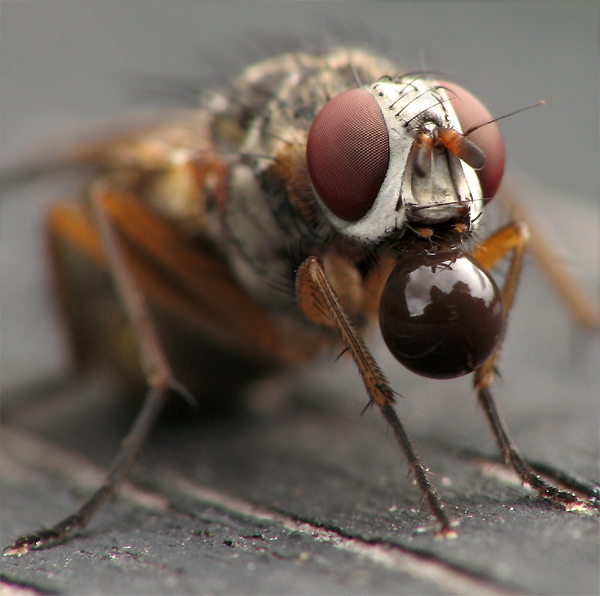#18
This article throws some light on bubbling phenomenon:
John G. Stoffolano Jr., and Aaron T. Haselton - The Adult Dipteran Crop: A Unique and Overlooked Organ. -
Annu. Rev. Entomol. 2013, 58:205-25
Abstract:
The diverticulated crop is a unique and overlooked foregut organ in the Diptera that affects many physiological and behavioral functions. Historically, the crop was viewed simply as a reservoir for excess nutrients. The crop lobes and crop duct form an elaborate sphincter and pump system that moves stored nutrients to the crop lobes, oral cavity, and the midgut. The storage capacity of the crop lobes is significant when filled maximally and supplies sufficient carbohydrates to sustain prolonged activity and flight, and adequate protein and lipids to facilitate reproductive events. Crop emptying is under complex neuroendocrine and neural control and may be influenced by multiple neuromessengers, such as serotonin and dromyosuppressin. The crop lobes also serve as a site for the initial mixing of enzymes from the salivary glands and antimicrobials from the labellar glands with ingested food. These food-processing functions are associated with behaviors unique to dipterans, such as regurgitation (or bubbling), nuptial gift giving, and substrate droplet deposition or trap-lining.
#19
Of the replies that I have had a look at so far amandafujikawa struck me as closest to the root of the matter. I have long been interested in this effect, and the first caveat is that any behaviour pattern so widespread is likely to have many component effects, so I am cautious about laying down the law.
However, here are a few points to ponder:
We usually see the behaviour in insects that feed on diluted fluids. (Bear in mind that there are similar cases of other insects that feed eg on plant saps or blood and have special adaptations for shedding excess water etc)
I have seen the behaviour most obvious in flies feeding on dung, nectar, insect blood (such as Milichiidae sharing the meals of crab spiders) and the like. Such foods occur episodically and one must feed as much as possible as fast as possible; the meal won't last and you need a lot of it, so grab what you can and hurry!
HOWEVER... with a full gut:
1: Lugging all the excess water reduces mobility, which is risky for flies.
2: While your crop is full you have no capacity for more
3: You can of course concentrate your gut content by fractionating it and excreting the diluted fluid, as many insects in fact do, but it is not always easy, though many mosquitoes do it after a blood meal.
4: However, you CAN produce a pendent droplet while you wait for your insides to deal with the rest. A droplet of such a small size has a considerable area/volume ratio and a rather tight surface curve, which promotes evaporation and concentration. Furthermore, surface tension can suspend such a small droplet quite securely.
I have seen similar bubbles (very seldom, but I had not been looking carefully) in SOLITARY bees ONLY. I rather suspect that they were males, but don't trust me on that!
Now, that would be consistent. Social or semi-social bees have no time to hang around evaporating drops in the open and they can do it more safely and maybe faster in a nice warm colony, with lots of their mates helping by fanning. Solitary bees have little advantage going back to the nest with diluted food, and will do better concentrating what they have at once, maybe able to top up with more nectar before leaving.
Flies have nowhere special to go and are in no hurry, but they might want to top up and might not wish to carry extra mass, though I never have seen a healthy fly so burdened that it was easy to catch!
So, I, the fly, sit and digest when I am full. I put my bowels to work concentrating what is inside, and as my crop is not a major organ of absorption, I dangle a nice big portion outside the crop where it can concentrate in the air. Maybe it will leave me with room for an extra portion in ten minutes or so, but even if not, a bit of concentration would do no harm.
I don't think the presence of oxygen in the surrounding air would be at all beneficial; digestion is as far as I can remember, an exclusively anoxic process; I cannot think of a single case where oxygen would be desirable.
In metabolism certainly, but not in digestion or assimilation; there we are more likely to want hydrolysis than oxidation. Oxidation is likely to destroy valuable nutrients or convert metallic micronutrients such as iron to undesirable oxidation states. So, for purposes of the dilute broth in my crop, I put up with the oxygen, but do not welcome it.
So, in summary, for years I have had no doubt that the overwhelming proportion of the function of the droplet dangling is evaporation.





